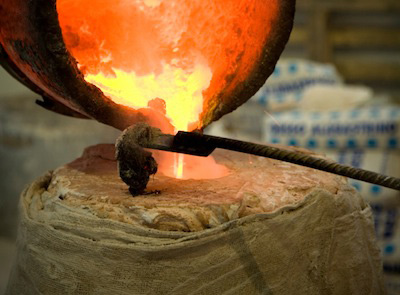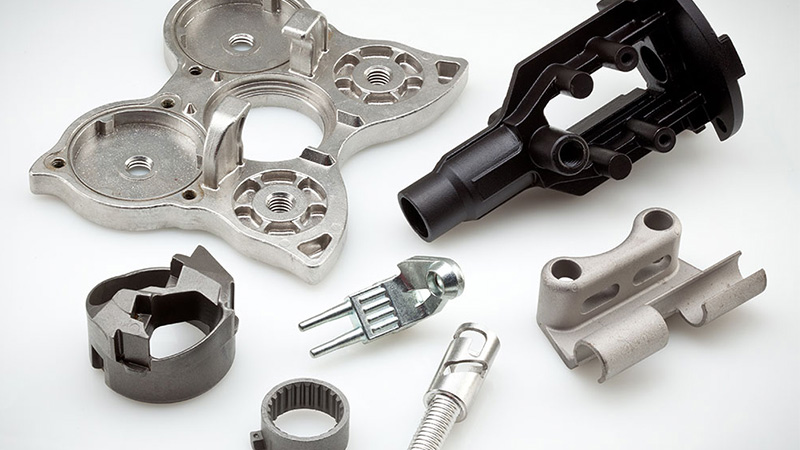Exploring advanced applications of Aluminum Castings in various fields
Wiki Article
Understanding the Metal Castings Process: A Comprehensive Overview for Beginners
The Metal Casting procedure is a fundamental technique in manufacturing that transforms molten steel into strong forms. Newbies have to grasp the various methods involved, such as sand spreading and die spreading. Recognizing the products, style principles, and safety and security measures is just as essential. Each facet plays a critical duty in attaining successful end results. As one navigates these complexities, the question of just how to optimize each action for improved outcomes ends up being progressively relevant.The Fundamentals of Metal Casting
Metal Casting has developed over centuries, its basic concepts stay constant and important to the production process. At its core, Metal Casting includes the improvement of molten steel into strong items through different techniques. The procedure begins with the development of a mold and mildew, which specifies the form of the last item. When the mold is prepared, metal is heated to its melting point and put right into the tooth cavity. After cooling, the metal solidifies, taking the form of the mold and mildew.There are a number of casting methods, including sand spreading, investment spreading, and pass away casting, each with one-of-a-kind advantages and applications. The selection of strategy relies on aspects such as manufacturing quantity, material type, and desired accuracy. Once cast, the final product may undertake added processes like machining or surface area treatment to accomplish the needed surface and specifications. Comprehending these basics is necessary for any individual curious about the field of Metal Casting.

Understanding Materials Made Use Of in Metal Casting
Products play a vital role in the Metal Casting process, affecting the end product's properties and efficiency. Numerous steels are made use of, consisting of light weight aluminum, bronze, iron, and steel, each offering unique qualities suited for specific applications. Light weight aluminum is lightweight and corrosion-resistant, making it perfect for auto components. Iron, especially cast iron, is preferred for its superb wear resistance and toughness. Steel gives high strength and flexibility, often utilized in hefty machinery parts. Bronze, recognized for its rust resistance and machinability, is frequently employed in marine applications.In addition to the metals, various casting products, such as sand, plaster, and ceramic, are utilized to create molds. Sand casting, the most widespread approach, utilizes silica sand because of its thermal stability and capacity to form complex forms. Plaster and ceramic mold and mildews provide finer information yet might call for more intricate procedures. The selection of materials straight impacts the efficiency, cost, and high quality of the casting operation.
The Style Process: From Idea to Blueprint
The style process in Metal Casting begins with the first idea growth, where ideas are created and evaluated. This is adhered to by the application of CAD modeling methods, permitting for precise visualizations of the design. The blueprint completion steps assure that all specifications are precisely documented for production.Preliminary Idea Development
Initial principle advancement marks a vital phase in the Metal Casting process, where concepts change into tangible designs. Throughout this phase, developers work together with stakeholders and engineers to brainstorm and fine-tune preliminary concepts. They consider variables such as performance, aesthetics, and manufacturability, making certain that the layout fulfills the needed specs and performance standards. Illustrations and rough drafts are created to envision the ideas, enabling for initial assessments of expediency and cost-effectiveness. This stage likewise involves identifying materials and possible spreading methods that align with the layout goals. Eventually, preliminary idea advancement prepares for a comprehensive blueprint, guiding the succeeding phases of the casting procedure and making certain a successful change from principle to fact.CAD Modeling Techniques
Changing concepts right into exact layouts, CAD modeling strategies play a crucial role in the Metal Casting process. These methods make use of sophisticated software program to produce thorough three-dimensional designs that precisely show the desired product. By utilizing tools such as parametric modeling, solid modeling, and surface modeling, designers can control measurements and forms with simplicity. CAD systems additionally help with simulation and evaluation, allowing for the identification of possible flaws before manufacturing begins. This positive technique reduces material waste and enhances the design for manufacturability. Additionally, CAD models can be quickly customized, making it possible for quick versions based on feedback. Essentially, CAD modeling works as the backbone of the style procedure, bridging the void between preliminary ideas and the ultimate production-ready styles.Plan Completion Steps
Complying with the production of detailed CAD models, the next stage involves blueprint completion, which is important in translating digital styles right into workable prepare for production. This procedure begins with examining the CAD versions for accuracy and conformity with specs. As soon as verified, the dimensions, tolerances, and material specifications are thoroughly outlined to guarantee clarity. Including comments and notes helps interact crucial details regarding casting procedures, surface coatings, and setting up demands. The completed plan undergoes a strenuous approval process, usually entailing cooperation with engineers and production groups to attend to any type of prospective problems. Nevertheless revisions are made and approvals obtained, the blueprint is officially released, acting as the fundamental document for the succeeding phases of Metal Casting, including pattern production and mold layout.The Metal Casting Techniques Described

Metal Casting methods incorporate a range of methods used to form molten steel right into desired types. These methods vary according to the kind of material, complexity of the style, and production volume. Sand casting is one of one of the most usual methods, including the creation of a mold from sand to hold the molten metal. Financial investment spreading, or lost-wax spreading, allows for intricate styles by utilizing a wax pattern that is melted away. Pass away casting employs high-pressure shot of molten steel into a mold and mildew, appropriate for mass manufacturing. Other approaches include long-term mold and mildew casting, which uses reusable molds, and centrifugal casting, where rotational forces help in loading the mold. Each technique has its benefits and applications, making it vital for makers to pick the appropriate approach based upon their particular demands and needs. Comprehending these techniques is vital for any person associated with the Metal Casting process.
Ending Up Procedures: Enhancing Your Casted Product

Finishing procedures play a vital duty in improving the high quality and look of casted items. Various surface area therapy strategies, such as polishing and finish, are employed to improve durability and visual appeals. In addition, quality inspection methods ensure that the last item meets specified requirements and efficiency demands.
Surface Area Treatment Techniques
A variety of surface therapy techniques play an essential duty in improving the quality and durability of casted products. These techniques consist of techniques such as shot blasting, polishing, and coating. Shot blasting effectively removes surface area imperfections, boosting the practical and aesthetic features of the casting. Sprucing up gives a smooth coating, which is particularly important for decorative applications and elements needing very little friction. Layer strategies, such as electroplating or powder finishing, deal additional defense versus rust and wear, making certain toughness. Additionally, surface area therapies can improve bond for succeeding procedures, such as painting or bonding. By utilizing these techniques, suppliers can attain premium surface high quality, which is crucial for the performance and lifespan of Metal Casting in numerous applications.Quality Inspection Approaches
Reliable top quality inspection methods are necessary for assuring the stability and efficiency of casted products after the finishing processes. Various methods are employed to analyze the quality of Metal Casting, including aesthetic examination, dimensional checks, and non-destructive testing (NDT) Aesthetic examination allows for the recognition of surface defects, while dimensional checks assure that items fulfill specified tolerances. NDT methods, such as ultrasonic screening and radiographic inspection, offer much deeper insights into inner honesty without harming the spreadings. In addition, mechanical testing, such as tensile and hardness examinations, reviews material homes - Wisconsin Aluminum Foundry. By using a combination of these approaches, makers can boost item quality and integrity, eventually resulting in greater consumer contentment and reduced production costsSafety Considerations in Metal Casting
While the Metal Casting procedure supplies countless advantages, it also provides a range of security dangers that must be very carefully handled. Workers in casting facilities are Metal Castings revealed to heats, molten metals, and unsafe products, which can bring about severe injuries if appropriate preventative measures are not taken. Individual protective equipment (PPE) such as heat-resistant gloves, encounter shields, and safety apparel is vital to minimize dangers.Furthermore, the visibility of fumes and dirt requires proper air flow systems to ensure air quality - Aluminum Castings. Normal training on safety and security procedures is vital for all staff members to identify possible threats and respond effectively. Emergency treatments need to be developed, consisting of fire safety procedures and first help accessibility. Upkeep of devices and appropriate handling of materials additionally add to a more secure working setting. By focusing on these safety and security considerations, Metal Casting procedures can secure their workforce and preserve reliable production processes
Regularly Asked Questions
What Are the Environmental Impacts of Metal Casting?
Metal Casting can lead to environmental effects such as air and water pollution, resource depletion, and energy consumption. Furthermore, incorrect waste management and discharges from foundries add to eco-friendly disruptions and health risks for neighboring areas.Just how Do I Choose the Right Steel for Casting?
To pick the ideal metal for spreading, one have to think about factors such as mechanical residential properties, rust resistance, thermal conductivity, and cost. Reviewing the intended application and ecological problems is vital for ideal choice.What Are the Typical Problems in Metal Casting?
Common defects in Metal Casting include porosity, contraction, sand addition, and misruns. These concerns frequently occur from inappropriate material choice, poor style, or imperfections in the casting process, influencing the end product's quality and efficiency.
Just How Can I Enhance My Metal Casting Abilities?
To enhance Metal Casting skills, one should exercise constantly, research study casting strategies, examine previous jobs for issues, look for responses from seasoned wheels, and constantly try out different products and methods to enhance efficiency and understanding.What Is the Cost of Beginning a Metal Casting Business?
Beginning a steel casting service normally requires a first financial investment of $5,000 to $50,000, depending on tools, materials, and center costs. Variables like place and range can substantially influence general start-up costs.The Metal Casting procedure is a fundamental strategy in manufacturing that transforms molten steel into solid kinds. Beginners have to grasp the different approaches involved, such as sand spreading and pass away casting. There are a number of casting approaches, consisting of sand spreading, investment casting, and pass away spreading, each with unique advantages and applications. Financial investment spreading, or lost-wax casting, allows for complex layouts by using a wax pattern that is melted away. Other techniques consist of irreversible mold casting, which makes use of multiple-use molds, and centrifugal casting, where rotational forces help in loading the mold and mildew.
Report this wiki page